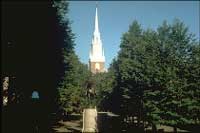





Survey of
Historic Sites and Buildings
  |
OLD NORTH CHURCH (Christ Church in Boston) (part of Boston National Historical Park) Massachusetts |
|
| ||
Ownership and Administration (1961). Corporation of Christ Church in the City of Boston.
Significance. Old North Church was built in 1723 by William Price, a book and print seller of Boston, from designs based on Christopher Wren's great London churches. Historically and architecturally, it is one of the Nation's most cherished landmarks. The signal lanterns hung in the church belfry—"One, if by land, and two, if by sea," as Longfellow put it—were not intended for Paul Revere, who had arranged for the signal. Nevertheless, despite the almost legendary quality of the story today, the lanterns did hang in the belfry on the night of April 18 to alert patriots on the opposite side of the Charles River that British troops were moving out of Boston by water. In addition to its role as a signal station on the eve of the Revolution, Old North possesses further distinction as Boston's oldest surviving church. With the adjacent equestrian statue of Paul Revere, it is a memorable evocation of the night when the call to arms went out and the War for Independence began.
 |
| Old North Church. (National Park Service) |
Present Appearance (1961). Old North Church was built of brick walls laid in English bond 51 feet wide and 70 feet long, with two tiers of arched windows. A projecting square brick tower nearly 100 feet high was added to the original structure in 1724-37 and topped by a wooden steeple 191 feet high in 1740. This first steeple was blown down in 1804 and replaced several years later by a similar one possibly designed by Charles Bulfinch. The second tower was toppled by a hurricane on August 31, 1954, and has since been replaced.
The interior is particularly valuable as an early example of the then-new "church" plan of a two-storied structure, with longitudinal aisles separating the groups of box pews, in contrast to the 17th-century "meetinghouse" plan that had a raised pulpit on one long side of the building with galleries at the other three sides. The origin of the new plan in Wren designs is shown also by the use to support the galleries of superimposed pillars, the lower square and the upper fluted.
The interior was restored carefully and thoroughly in 1912-14, when a number of 19th-century alterations were eliminated. A stone tablet placed on the tower in 1878 identifies it as the place where the signal lanterns burned on the night of April 18, 1775. The church is well maintained, although its crowded surroundings detract from the setting and constitute a fire hazard to the building. More than 200,000 people visit the landmark annually. [27]
 |
 |
http://www.cr.nps.gov/history/online_books/colonials-patriots/sitec16.htm
Last Updated: 09-Jan-2005